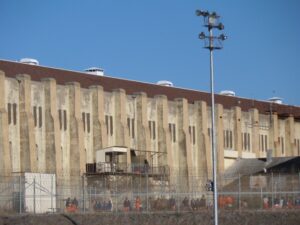
The Prison System’s Next Opportunity: Drone Tracking and Protection Against Threats to Airspace Security
Keeping drones out of prison airspace has become a critical challenge. Here, experts at airspace security and drone forensics firm SkySafe discuss how stakeholders can protect correctional facilities.
Continue reading below, or listen:
The following is a guest post by Emily Rhodes, VP of Marketing at SkySafe. DRONELIFE neither accepts nor makes payments for guest posts.
With drones accessible to the general public, secure facilities like prisons are encountering skyrocketing cases of contraband, including cell phones, food, drugs, and weapons, from their airspace. This nefarious activity can create perilous situations for those inside and outside the prison walls. A report by the U.S. Department of Justice found that, on average, illegal UAV drops increase by 50% or more annually – a rate that continues to worsen.
Beyond delivering drugs to inmates, drones are also being used for more sinister plots, including fascinating escapes and dropping weapons that pose immediate threats to other inmates and prison staff. This has become a nightmare for surrounding communities, businesses, and schools.
Inmates have long worked with corrupt prison employees and contacts outside the prison to import contraband. Drones now have expedited the ability to drop contraband directly onto prison yards by flying above the sally port, posing a significant risk to the safety of inmates and staff members. So, how do prison officials account for these threats?
The Federal Aviation Administration (FAA) has issued no-fly areas over many Federal Bureau of Prisons (BOP) facilities, which has helped shut down some of these drone operations and identify perpetrators. Unfortunately, BOP staffing shortages have made tracking and intercepting drones difficult. As a result, prison systems are turning to drone tracking technology and critical data insights to detect, protect, and resolve dangerous drone threats.
The Power of Drone Data
To effectively thwart illegal drone activity, antiquated systems that can identify airborne objects no longer serve as the frontline of prison defense. Drone tracking enables prisons to achieve comprehensive airspace awareness by monitoring and eliminating drones attempting to smuggle contraband. This is accomplished using advanced radio technology, reverse engineering, and deep threat analysis.
Drone activity can be detected using networks that identify drones in the compromised airspace and determine the drone’s flight path and from where it originated. Drone monitoring technology can effectively provide operator identification through drone tracking from takeoff, with real-time monitoring of the current operator location. Tapping into this critical data is vital for understanding the drone’s operation and preventing future threats from the same source.
Drones for Good
While drones operated by criminal enterprises create substantial issues for prisons, they can be used for good under the right direction. For example, many local police departments utilize drones for search and rescue operations and on-site surveying of active emergencies to accurately determine what’s happening and where first responders must go to take care of victims. Prison officials can use the same tactics for crowd monitoring and lockdown situations.
There has been a mass exodus of employees in many careers, and corrections is no different. Correctional officers have become exceedingly difficult not only to hire but to retain. Many are frustrated with the long work hours, violent environments, and isolated work locations. This is happening as many politicians push for harsher sentences, increasing prison populations. In some states, the shortage of correctional officers has forced elected officials to declare a state of emergency, calling in the National Guard to assist in the staffing of prisons. Implementing drone defense management strategies will ensure secure airspace is screened for malicious drones and made safe for drones used for good.
Data-Enabled Awareness
In the early days of consumer adoption, drones were tough to detect and track, so it’s impossible to know how many drone drops have gone undetected. Fortunately, tech advancements that leverage real-time drone data and analytics enable enhanced, comprehensive airspace awareness.
A cloud-enabled drone tracking network can be set up quickly, and the cloud offers remote support so prison staff can focus on what’s happening inside the prison while the network focuses on what’s happening above it. Once set up, prisons can manage drone detection by logging into a dashboard to monitor activity and receive alerts. If any airspace activity is detected, automated notifications will immediately be sent to the proper chain of command within the prison. Prisons and jails have direct visibility into the drone’s flight path, where it launched from, if it has flown into the airspace previously, and where it goes afterward.
Looking Ahead
As the prison system continues to combat the illegal delivery of contraband via drones, the answer to this problem lies in technology. Thanks to significant advancements, drone data for decision-making, and enhanced visibility into their origins, prison authorities and law enforcement agencies can work cohesively to identify and prosecute those who use drones to deliver contraband into prisons and keep the airspace clear and secure.
Read more:
- Drone Forensics: SkySafe on the Drone Radio Show!
- Drone Forensics is a Critical Aspect of Counter Drone Programs: SkySafe Develops Certification
- Airspace Security: SkySafe Raises $30 Million to Scale Growth
- SkySafe Raises $11.5 Mill for Counter-UAS Technology; Secures DoD Contract
Miriam McNabb is the Editor-in-Chief of DRONELIFE and CEO of JobForDrones, a professional drone services marketplace, and a fascinated observer of the emerging drone industry and the regulatory environment for drones. Miriam has penned over 3,000 articles focused on the commercial drone space and is an international speaker and recognized figure in the industry. Miriam has a degree from the University of Chicago and over 20 years of experience in high tech sales and marketing for new technologies.
For drone industry consulting or writing, Email Miriam.
TWITTER:@spaldingbarker
Subscribe to DroneLife here.